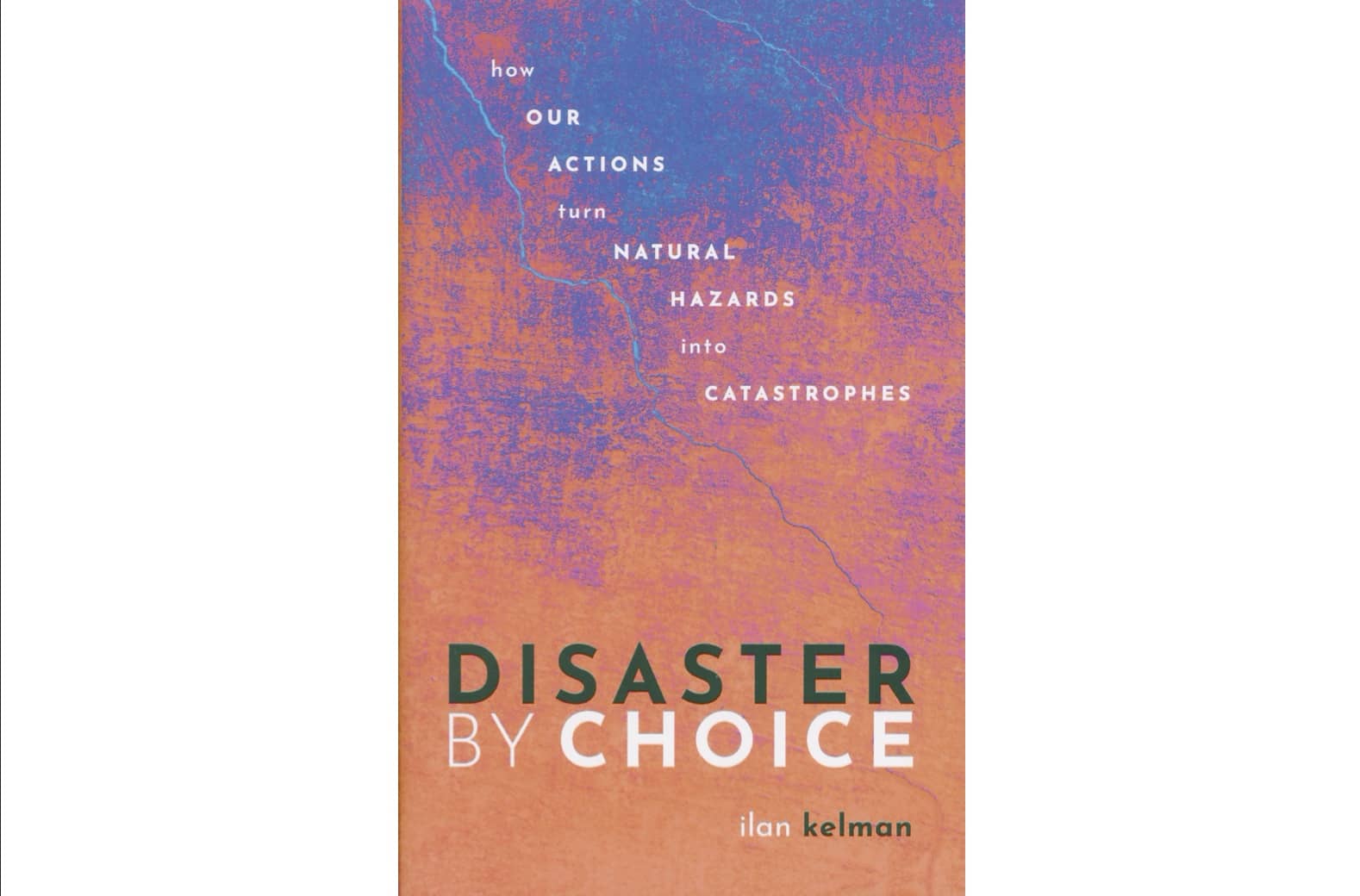
www.buildingsandcities.org/insights/reviews/disaster-choice-how-our-actions-turn.html
Disaster by Choice: How our Actions turn Natural Hazards into Catastrophes

By Ilan Kelman. Oxford University Press, 2020, ISBN: 9780198841340
James Lewis (Datum International) reviews this book which
provides significant insights into what really causes disasters and how to avoid them in
policy, strategy and practice. Natural disasters are not "natural", they are hazards that are amplified into disasters as a consequence of human actions. Making more intelligent choices about these hazards will reduce our vulnerability.
The arrival of this perfectly crafted and well written book is ideally timed. The dramatic current onset of climate-related disasters, wildfires, storms and floods around the world, the sudden emergence of the climate emergency movement, and the COVID-19 pandemic provide a fitting context. As the author so profusely describes, our vulnerability to these present hazards was created years ago. This book is long overdue, much needed and greatly welcomed.
In this passionately informed demonstration of realities, Kelman makes a distinction between the hazard, which is natural, and the disaster which is not. It very thoroughly explains that 'natural disasters' are not natural at all. These events are caused by shortcomings of humankind. A disaster lies not in the forces unleashed by nature, but in its impacts on human society. These include deaths and injuries, the loss of irreplaceable homes and livelihoods, and the failure to support affected people, so that a short-term interruption becomes a long-term recovery nightmare.
Neither the tornado, the earthquake nor the tsunami are to blame. They are each manifestations of nature which have occurred countless times over the aeons of Earth's history. The disaster consists of a societal inability to deal with hazards as part of the natural contexts in which we live. We have the knowledge, ability, technology, and resources to build houses which are not ripped apart by high winds. Or we could choose to create a culture with warning and safe sheltering. Or we could avoid places likely to be hit. Or we could accept periodic destruction (with warning systems and safe evacuation) to permit rebuilding afterwards. The key message is that options exist for choosing where we live, how we build, and how we prepare ourselves for living with nature. Many of the current choices permit death and devastation. Collectively and individually, we create the conditions for disasters. Nature does not choose, but we do. It is our choice to avoid disasters - which means disasters are not natural.
Straightforward and brilliantly described accounts are provided of how disasters are caused by vulnerabilities to natural hazards. This book should be compulsory reading by those whose actions and inactions create vulnerabilities: leaders of national, state and local governments, heads and members of all authorities related to environment, agriculture, forestry, water courses, shorelines and for power supplies, public health, finance, education, construction, architecture and civil engineering - and those in educational institutions associated with all of these. Its reading will introduce each discipline and activity to its specific responsibilities. The book also provides a multidisciplinary perspective. It offers insights and alternatives to the narrow thinking resulting from departmentalism.
Not all human disasters are sudden events or noted in the news. Many occur with regularity due to a lack of human agency and planning. The fact that these have become routine does not mean they are acceptable. For example, normal, seasonal weather regularly kills thousands annually from hot and humid or cold and windy weather. If all of us could afford adequate indoor temperature control, then we could make a choice about heating and cooling our rooms. Why do large segments of the populations have trouble providing themselves with such a basic necessity? Vulnerability by economics is more an issue of family finances. It raises social questions about our response to natural hazards: why energy costs are not affordable for everyone; why residential buildings are not designed or retrofitted for weather variations and why those in rented accommodation are typically more fuel impoverished than owner occupiers. Not all vulnerability by economics is a one-way street. Even where poverty leads to vulnerability, the converse of vulnerability leading to poverty also emerges. Without addressing vulnerability over the longer term, poverty will be both a cause and a consequence of disasters that repeatedly recur.
Ultimately, vulnerability is due to political decisions. To address this problem, Kelman suggests new processes are needed to identify and confront people, organisations and procedures that lead to harmful decisions. Other reasons why vulnerabilities are not overcome relate to excessive ideologies, governance, prejudices, assumptions, power relations, and obstructed access to alternative choices. In most circumstances, certain groups within society make choices for other groups, making or breaking the others' vulnerability. Delving into the nature and causes of vulnerability makes it clear that people are not inherently vulnerable to hazards, but are made vulnerable by society.
When so much current research and political attention is being focused upon people's resilience, this in-depth examination of vulnerability and its causes reveals why, in disaster aftermath, people may have low capacity and capability. The notion of resilience depends upon the assumed capacities and capabilities of people which perhaps explains why governments and authorities make it their preferred option. However, this often fails to counter the causes that can reduce those capacities and capabilities. This book restores the underlying reasons and causes of why people are as they are; it rejects how they are as its starting point.
Disasters reveal the fundamental realities of society and expose the world as it is. Disasters may also provide opportunity for change but often at great human suffering. The beauty of Kelman's book is it also provide an opportunity to change. The book's observations and recommendations require changes in comprehension, systems of governance and reallocations of responsibility and of power. This book is a timely study of urgent worldwide situations of climate change, environmental management and pandemic requiring serious application. It will also help move us toward evidence-based policy. The sooner it is widely read and acted upon, the better the world will be for everyone.Latest Peer-Reviewed Journal Content
A living lab approach to co-designing climate adaptation strategies
M K Barati & S Bankaru-Swamy
Mediation roles and ecologies within resilience-focused urban living labs
N Antaki, D Petrescu, M Schalk, E Brandao, D Calciu & V Marin
Negotiating expertise in Nepal’s post-earthquake disaster reconstruction
K Rankin, M Suji, B Pandey, J Baniya, D V Hirslund, B Limbu, N Rawal & S Shneiderman
Designing for pro-environmental behaviour change: the aspiration–reality gap
J Simpson & J Uttley
Lifetimes of demolished buildings in US and European cities
J Berglund-Brown, I Dobie, J Hewitt, C De Wolf & J Ochsendorf
Expanding the framework of urban living labs using grassroots methods
T Ahmed, I Delsante & L Migliavacca
Youth engagement in urban living labs: tools, methods and pedagogies
N Charalambous, C Panayi, C Mady, T Augustinčić & D Berc
Co-creating urban transformation: a stakeholder analysis for Germany’s heat transition
P Heger, C Bieber, M Hendawy & A Shooshtari
Placemaking living lab: creating resilient social and spatial infrastructures
M Dodd, N Madabhushi & R Lees
Church pipe organs: historical tuning records as indoor environmental evidence
B Bingley, A Knight & Y Xing
A framework for 1.5°C-aligned GHG budgets in architecture
G Betti, I Spaar, D Bachmann, A Jerosch-Herold, E Kühner, R Yang, K Avhad & S Sinning
Net zero retrofit of the building stock [editorial]
D Godoy-Shimizu & P Steadman
Co-learning in living labs: nurturing civic agency and resilience
A Belfield
The importance of multi-roles and code-switching in living labs
H Noller & A Tarik
Researchers’ shifting roles in living labs for knowledge co-production
C-C Dobre & G Faldi
Increasing civic resilience in urban living labs: city authorities’ roles
E Alatalo, M Laine & M Kyrönviita
Co-curation as civic practice in community engagement
Z Li, M Sunikka-Blank, R Purohit & F Samuel
Preserving buildings: emission reductions from circular economy strategies in Austria
N Alaux, V Kulmer, J Vogel & A Passer
Urban living labs: relationality between institutions and local circularity
P Palo, M Adelfio, J Lundin & E Brandão
Living labs: epistemic modelling, temporariness and land value
J Clossick, T Khonsari & U Steven
Co-creating interventions to prevent mosquito-borne disease transmission in hospitals
O Sloan Wood, E Lupenza, D M Agnello, J B Knudsen, M Msellem, K L Schiøler & F Saleh
Circularity at the neighbourhood scale: co-creative living lab lessons
J Honsa, A Versele, T Van de Kerckhove & C Piccardo
Positive energy districts and energy communities: how living labs create value
E Malakhatka, O Shafqat, A Sandoff & L Thuvander
Built environment governance and professionalism: the end of laissez-faire (again)
S Foxell
Co-creating justice in housing energy transitions through energy living labs
D Ricci, C Leiwakabessy, S van Wieringen, P de Koning & T Konstantinou
HVAC characterisation of existing Canadian buildings for decarbonisation retrofit identification
J Adebisi & J J McArthur
Simulation and the building performance gap [editorial]
M Donn
Developing criteria for effective building-sector commitments in nationally determined contributions
P Graham, K McFarlane & M Taheri
Join Our Community

The most important part of any journal is our people – readers, authors, reviewers, editorial board members and editors. You are cordially invited to join our community by joining our mailing list. We send out occasional emails about the journal – calls for papers, special issues, events and more.
We will not share your email with third parties. Read more



Latest Commentaries
COP30 Report
Matti Kuittinen (Aalto University) reflects on his experience of attending the 2025 UN Conference of the Parties in Belém, Brazil. The roadmaps and commitments failed to deliver the objectives of the 2025 Paris Agreement. However, 2 countries - Japan and Senegal - announced they are creating roadmaps to decarbonise their buildings. An international group of government ministers put housing on the agenda - specifying the need for reduced carbon and energy use along with affordability, quality and climate resilience.
Building-Related Research: New Context, New Challenges
Raymond J. Cole (University of British Columbia) reflects on the key challenges raised in the 34 commissioned essays for Buildings & Cities 5th anniversary. Not only are key research issues identified, but the consequences of changing contexts for conducting research and tailoring its influence on society are highlighted as key areas of action.